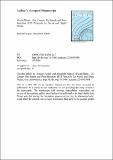Files in this item
#FoundThem - 21st century pre-search and post-detection SETI protocols for social and digital media
Item metadata
| dc.contributor.author | Forgan, Duncan | |
| dc.contributor.author | Scholz, Alexander | |
| dc.date.accessioned | 2017-05-10T23:33:45Z | |
| dc.date.available | 2017-05-10T23:33:45Z | |
| dc.date.issued | 2016-09 | |
| dc.identifier | 242503923 | |
| dc.identifier | 40e3eda4-8e34-4e32-88e1-33f3b5ee3a59 | |
| dc.identifier | 84969921119 | |
| dc.identifier | 000382412200032 | |
| dc.identifier.citation | Forgan , D & Scholz , A 2016 , ' #FoundThem - 21st century pre-search and post-detection SETI protocols for social and digital media ' , Acta Astronautica , vol. 126 , pp. 312-315 . https://doi.org/10.1016/j.actaastro.2016.05.008 | en |
| dc.identifier.issn | 0094-5765 | |
| dc.identifier.other | RIS: urn:6A2B8B77470BEDA8D32F2F5B4F56C2C4 | |
| dc.identifier.other | BibCode: 2016arXiv160502947F | |
| dc.identifier.uri | https://hdl.handle.net/10023/10743 | |
| dc.description.abstract | The transmission of news stories in global culture has changed fundamentally in the last three decades. The general public are alerted to breaking stories on increasingly rapid timescales, and the discussion/distortion of facts by writers, bloggers, commenters and Internet users can also be extremely fast. The narrative of a news item no longer belongs to a small cadre of conventional media outlets, but is instead synthesised to some level by the public as they select where and how they consume news. The IAA Search for Extraterrestrial Intelligence (SETI) post-detection protocols, initially drafted in 1989 and updated in 2010, were written to guide SETI scientists in the event of detecting evidence of extraterrestrial intelligence, but do not give guidance as to how scientists should prepare to navigate this media maelstrom. The protocols assume communication channels between scientists and the public still resemble those of 1989, which were specifically one-way with a narrative controlled by a select few media outlets. Modern SETI researchers must consider this modern paradigm for consumption of news by the public, using social media and other non-traditional outlets, when planning and executing searches for extraterrestrial intelligence. We propose additions to the post detection protocols as they pertain to the use of the Internet and social media, as well as pre-search protocols. It is our belief that such protocols are necessary if there is to be a well-informed, sane global conversation amongst the world’s citizens following the discovery of intelligent life beyond the Earth. | |
| dc.format.extent | 620511 | |
| dc.language.iso | eng | |
| dc.relation.ispartof | Acta Astronautica | en |
| dc.subject | SETI | en |
| dc.subject | Astrobiology | en |
| dc.subject | Protocols | en |
| dc.subject | Science communication | en |
| dc.subject | QB Astronomy | en |
| dc.subject | QH301 Biology | en |
| dc.subject | QC Physics | en |
| dc.subject | T-NDAS | en |
| dc.subject.lcc | QB | en |
| dc.subject.lcc | QH301 | en |
| dc.subject.lcc | QC | en |
| dc.title | #FoundThem - 21st century pre-search and post-detection SETI protocols for social and digital media | en |
| dc.type | Journal article | en |
| dc.contributor.institution | University of St Andrews. School of Physics and Astronomy | en |
| dc.identifier.doi | https://doi.org/10.1016/j.actaastro.2016.05.008 | |
| dc.description.status | Peer reviewed | en |
| dc.date.embargoedUntil | 2017-05-10 | |
| dc.identifier.url | http://adsabs.harvard.edu/abs/2016arXiv160502947F | en |
This item appears in the following Collection(s)
Items in the St Andrews Research Repository are protected by copyright, with all rights reserved, unless otherwise indicated.

